(Strand)om Stories: Deathlok the Demolisher: The Complete Collection Review
This volume starts strong before struggling through a messy middle, concluding powerfully as it focuses on a cyborg assassin who was once a man
—by Nathan on August 30, 2023—
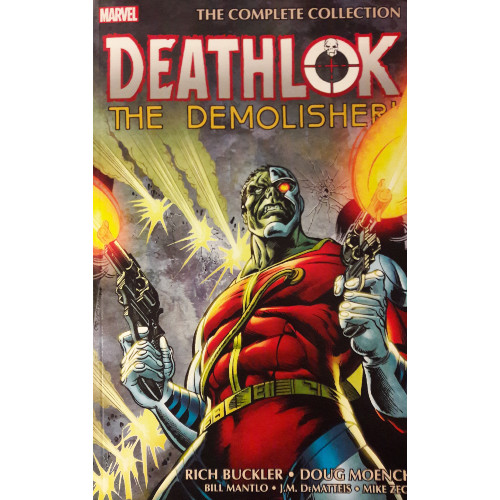
The cover of 1962’s Incredible Hulk #1 famously bears the tagline, “Is he man or monster or…is he both?” The question pokes at the duality of the rampaging gray Goliath in his first appearance, the Dr. Jekyll/Mr. Hyde split between mild-mannered milksop (General Thaddeus “Thunderbolt” Ross’ words, not mine) Bruce Banner and his horrendous, huge alter ego. Just who lies at the center of this powerhouse–the behemoth or the boy?
You could slap a similar tagline onto the cover of 1974’s Astonishing Tales #25: “Is he man or machine or…is he both?” Much like the Jade Giant, the cyborg known as Deathlok the Demolisher began life as a man divided: human flesh wrapped in cybernetic appendages, synced to a computer in his brain. Created by artist Rich Buckler, Deathlok stormed the pages of his first issue a hunter, a killer, a creature broken and torn between the humanity he felt and the computer commanding he respond in an unthinking, unfeeling manner.
A while back, I purchased a Complete Collection gathering Deathlok’s first several appearances, containing an entire arc crafted by Buckler and other creative individuals. As Deathlok was a key figure in a revival of the Sinister Six I recently reviewed (albeit, a different version of the rogue cuborg), I figured now would be an appropriate time to dig into the character's inner workings, to see where man and machine mesh…and, to perhaps a greater extent, where they grind rather than graft.
Deathlok the Demolisher: The Complete Collection
Writers: Rich Buckler, Doug Moench, Bill Mantlo, David Anthony Kraft, Marv Wolfman, Ralph Macchio, Mark Gruenwald, J.M. DeMatteis
Pencilers: Rich Buckler, Keith Pollard, Arvell Jones, Bob McLeod, Sal Buscema, Michael Netzer, Ron Wilson, John Byrne, Mike Zeck, and Michael Golden
Inkers: Rich Buckler, Klaus Janson, Al Milgrom, Mike Esposito, Pablo Marcos, Al McWilliams, Keith Pollard, Bob McLeod, John Tartaglione, Joe Sinnott, John Beatty, and Bob Downs
Colorists: Glynis Wein, Linda Lessman, George Roussos, Janice Cohen, Klaus Janson, Rich Buckler, Petra Goldberg, Don Warfield, Len Wein, Irene Vartanoff, Sam Kato, and Bob Sharen
Letterers: Annette Kawecki, Desmond Jones, Karen Pocock, Charlotte Jetter, Janice Chiang, Irving Watanabe, Beth Bleckley, Karen Mantlo, Howard Bender, John Costanza, Bruce Patterson, Diana Albers, and A.R.K.
Issues Collected: Astonishing Tales #25-28 and #30-36, Marvel Spotlight #33, Marvel Team-Up #46, Marvel Two-In-One #27 and #54, Captain America #286-288, and material from Marvel Two-In-One #28, #34, and #53 and Marvel Fanfare #4
Volume Publication Date: October 2014
Issue Publication Dates: August 1974, October 1974, December 1974, February 1975, June 1975, August 1975, November 1975, January 1976, March 1976, May-July 1976, April 1977, May-June 1977, December 1977, July 1979, August 1979, September 1982, November-December 1983
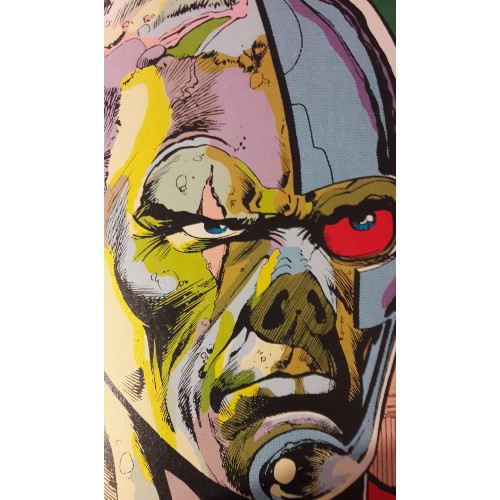
Sporting perhaps the best tagline I have ever seen on a trade’s back cover (“His body may not be complete, but this collection is!”), Deathlok the Demolisher: The Complete Collection presents a narrative just as much a patchwork zombie as its central character. Much like the cyborg assassin in question is constructed from human bits and cybernetic accoutrements, this volume is a menagerie of writers, artists, inkers, and colorists, all etching chapters of a larger tale told over nine years across five different Marvel titles, not counting the Marvel Fanfare backup strip (which I've briefly discussed before) closing out the volume.
In short, it’s a mess. But not a wholly unwelcome mess.
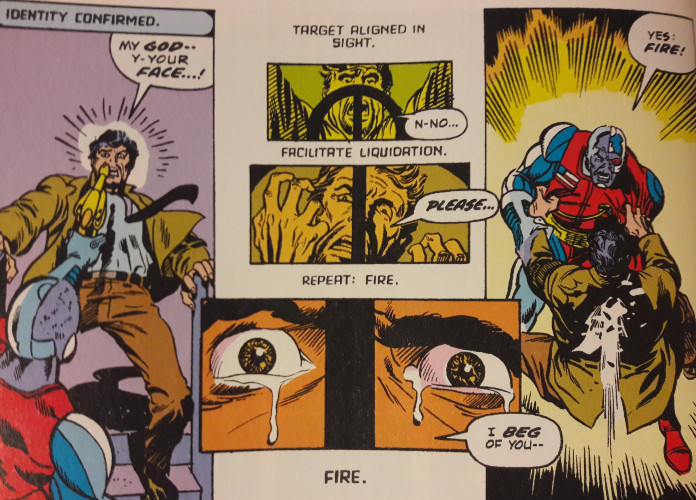
I’ll be honest up front: the collection decays the deeper you delve, the story relying on further augmentation and struggling to find life in Deathlok’s heart past the Astonishing Tales chapters primarily presented by Buckler, Doug Monech, and Bill Mantlo. I hold all three men in relatively high esteem–I’ve discussed my appreciation of Buckler’s work on Don McGregor’s “Panther’s Rage” and Peter David’s “The Death of Jean DeWolff”; I recently gave Moench high praise for his creation of the enigmatic Moon Knight; and Mantlo gifted us with Cloak and Dagger. Mantlo’s writing stands out from Moench’s, particularly as Moench’s work with Moon Knight and Batman introduced me to an edgier voice prior to reading his Deathlok material. Mantlo bobbled attempts at injecting serious commentary in his Cloak and Dagger narratives, but here, he delivers engaging narration and aptly examines a world in the throes of decay.
We’re immediately thrust into the then-future world of the 1990s, a cesspool of dying cities and dying men. Deathlok, former soldier Luther Manning, is an assassin-for-hire, carrying out deadly missions as he creeps ever closer to his primary goal: the death of Major Simon Ryker, Manning’s former commander and the man responsible for transforming Manning into the first of a new breed of cyborg super-soldiers. The revenge plot is injected quickly, forming the crux of the entire Astonishing Tales run…and it seems, at moments, the only plot element conceived of prior to the writing.
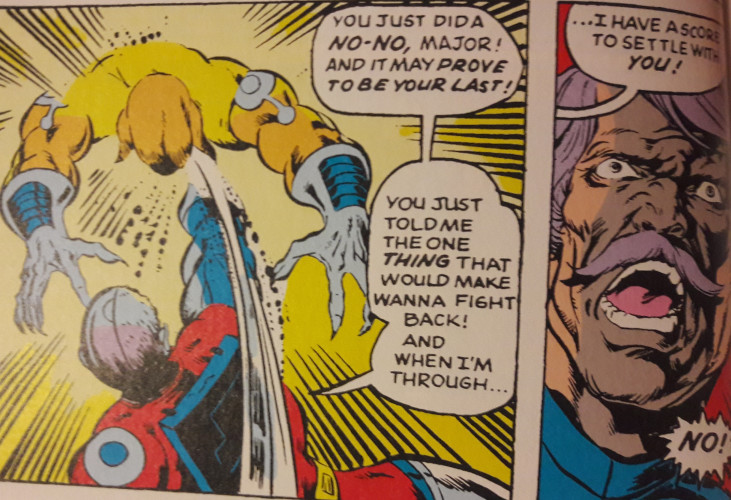
There’s a sense very vague planning went into creating a story around Deathlok once the character was invented. Chapters feel developed on the fly as Deathlok moves from one “threat of the week” to the next–a cyborg wolf, a tank, and thugs and cannibals employed by Ryker. The narrative’s main thrust always moves the metal man forward, but the details feel haphazardly filled in, as if Buckler and Co. knew where they wanted to go but made up how to get there as they went along. Look no further than an issue that sees three plot twists stacked atop each other–a supporting character thought dead is revealed to be a cyborg, a claim made by a villain which is then recanted, only for the same villain to alert the audience the character is alive while Deathlok stews in ignorance. The rapid-fire rat-a-tat of sudden developments lends the narrative a very spontaneous nature. The series, told in this style, feels akin to “Panther’s Rage,” which maneuvered similarly, transporting T’Challa from place to place, having him encounter villain after villain. The plotting of “Panther’s Rage,” however, felt deliberate on McGregor’s part. Not so much here.
The method feels like a bridge between standalone issues told in the 60s–where Spider-Man would fight the Vulture, then Doctor Octopus, then the Sandman, with subplots and recurring characters tethering chapters together rather than long-running stories–and narratives that would continue developing into grander, multi-issue epics. Multi-part narratives existed back in the day, sure–Stan Lee and Jack Kirby’s “Galactus Trilogy” or their three-part Sentinel saga in X-Men, for example–but the Astonishing Tales issue feel like a more distinct, more defined version of developing an overarching story while still trying to retain that monthly appeal. Captions and dialogue bubbles frequently recap the prior issues’ events, inviting newer readers in medias res while reminding continuing readers where the last issue left off–presumably, a helpful tool when considering these issues were published once every two months. Chapters generally end on a cliffhanger of sorts, such as Deathlok winding up face-to-face with a charging tank or swearing ill-will on a helicopter, promising further action and suspense in the next issue.
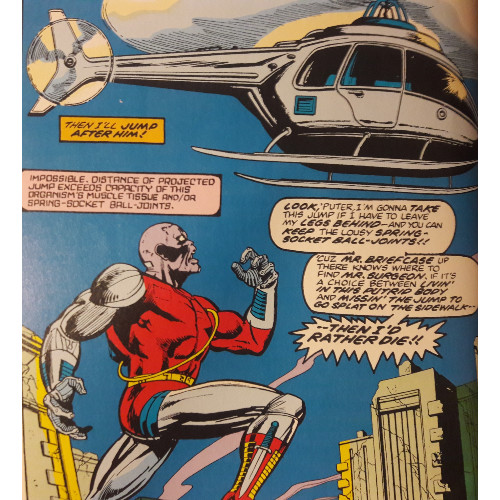
Read back-to-back, the process is a little repetitive, especially when issues begin right where the last issue ended; sometimes, these opening pages alter dialogue and, very occasionally, minor plot points, creating a bizarre experience when read together as a running narrative. Yet the bulk of the issues, despite some minor incongruities, work relatively well as a broader narrative. Even if the plot feels hastily constructed, we are given a path to follow as Manning’s mechanical alter ego proceeds through the wasteland that was once New York, dogged and defiant in his mission.
The plot may seem underdeveloped at moments, but Deathlok himself feels more fleshed-out, a bizarre yet appropriate phrase to describe the seemingly undead cyborg assassin. Pieces of backstory are developed over time, and we learn more about Deathlok’s past and family as he dwells on his pre-reprogrammed days. Buckler, in conceiving the character, ably introduces unique internal conflict in quite a literal fashion–Deathlok is truly a man divided, torn between his human thoughts and emotions and the “‘puter” inside him which demands cold determination. Dialogue boxes encapsulate an internal war between Deathlok and the computer, mirthless digital text often stating the obvious, offering on-the-nose observations, and clashing with Manning’s emotionally “compromised” thoughts and reactions. Moench, in particular, finds humor in the computer’s penchant for noting danger Deathlok can already sense or see, the machine’s redundancy amusingly butting heads with its own calculating efficiency.
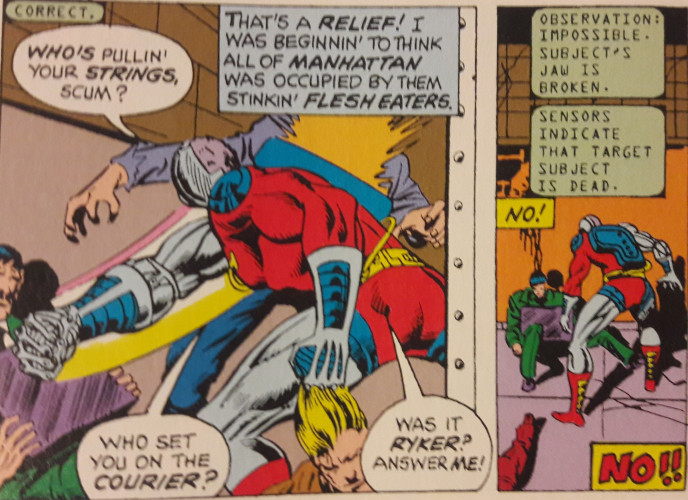
Moench and Mantlo manage the “man” in Manning effectively, his personality driven by constantly striving against the limitations of his programming, seeking a soul where Ryker ripped the life out of him. The struggle creates empathy in the reader for Deathlok’s situation and drives the reading experience onward through questioning whether or not Manning can reclaim the life he once had or if he needs to become content with the life he has now.
For much of the volume, Deathlok remains in his own timeline, separate from the rest of the Marvel Universe. As Astonishing Tales wraps up, however, other writers and artists drag him into the primary Marvel timeline, forcing him to interact with Spider-Man, the Fantastic Four, Captain America, and the Thing (both with and separate from the FF). Though Moench, Mantlo, and Buckler wrap up a good chunk of their narrative in Astonishing Tales, a burgeoning subplot remains unfinished…and though we eventually get a resolution in a trilogy of Captain America issues, most of Deathlok’s time outside Astonishing Tales is spent as an aimless assassin. Writers such as Ralph Macchio and Mark Gruenwald seem to appreciate the character’s conceit but fail to incorporate him beyond “mindless machine man piloted by mind control.” Deathlok, who just spent at least ten Astonishing Tales issues struggling between his human nature and his cybernetic side, once again becomes a ragdoll or a puppet with little agency.
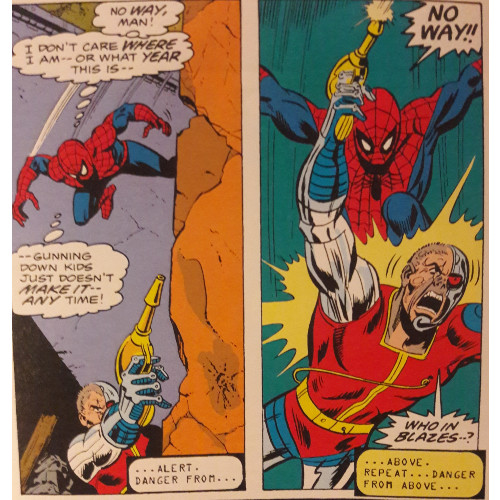
J.M. DeMatteis, partnered with his “Kraven’s Last Hunt” collaborator Mike Zeck, does his best to massage these disparate pieces of story in the Captain America issues. Some long-winded but much-needed exposition takes stock of all that has happened before and works to weave the fragments into a coherent quilt–and largely succeeds. DeMatteis ignores one blatant error which occurs between a Marvel Spotlight and Marvel Two-in-One issue but does his best to find synergy between the seemingly disparate Marvel Team-Up, Marvel Two-in-One, and Captain America issues. To his credit, he wraps up Luther Manning’s story well, returning to seemingly abandoned subplots and focusing his tale through the human/cyborg conflict which propelled Buckler’s original plot.
This isn’t to say Mantlo, Macchio, and Gruenwald fail to craft engaging plots when separated from the Deathlok-focused narrative–in truth, one Marvel Two-in-One issue finds the cyborg in the midst of another story, the Thing-centric “Project Pegasus,” encouraging me to take a gander at a volume I own collecting the whole saga (which will hopefully be reviewed at a blog near you). An assassination attempt on President Jimmy Carter holds some intrigue, and a team up between Deathlok and Spider-Man allows Mantlo to bring some humor to the rather mirthless future Deathlok inhabits. On their own, each issue provides a coherent narrative, even if only as a chapter of a larger saga at times; it’s just they muddy Buckler’s original intentions in places, including the cyborg in moments which feel tonally different than what Buckler, Mantlo, and Moench established previously.
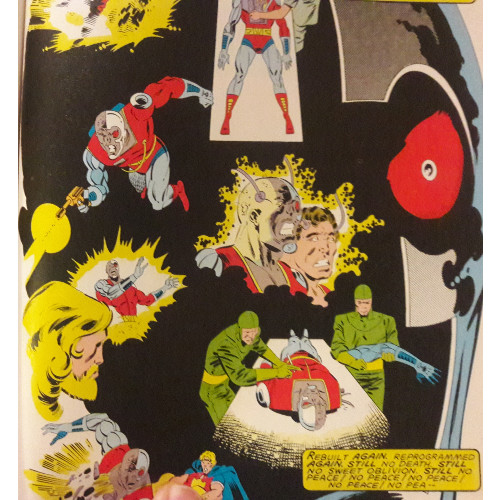
It should not come as a surprise that this volume feels like a cyborg itself…a mess, as I alluded to earlier. The second half feels mismatched when held up to the first, a mishmash of ideas and subplots strewn together, with Deathlok haphazardly thrown in. Fortunately, a middling muddle of a middle cannot take away from Buckler’ inspired Astonishing Tales issues or DeMatteis’ necessary conclusion. Buckler’s vision may have been lost when other hands took hold of his creation, further Frankenstein-ing the assassin, but DeMatteis salvages the remnants, resorting Deathlok to his former status as a man divided, stretching and yearning for freedom, breaking the bonds imposed upon him, and determining for himself what it means to become a man, even if he’s never fully human.